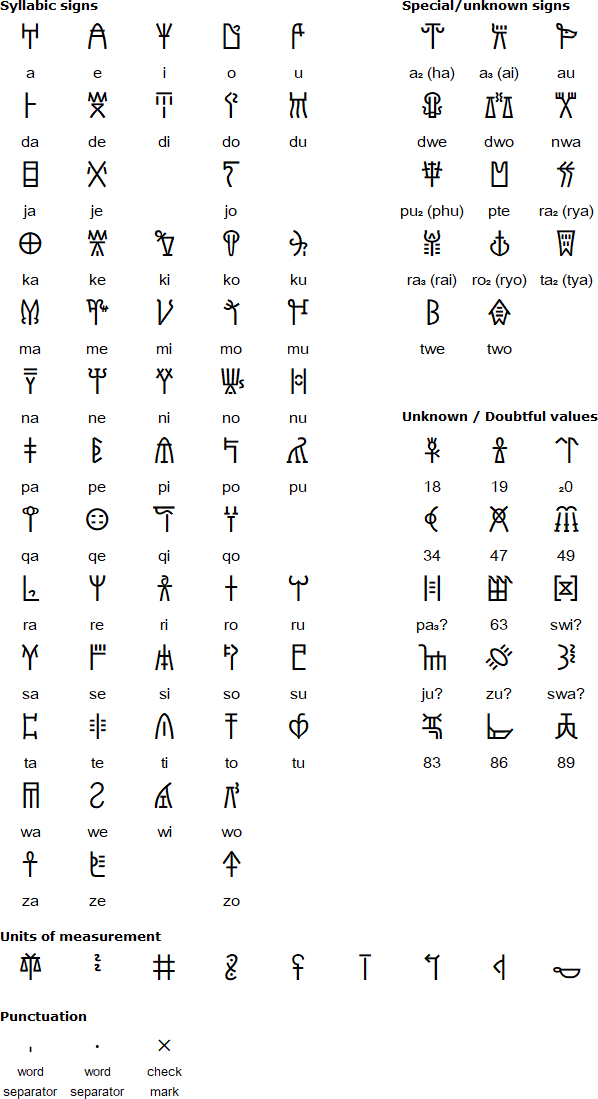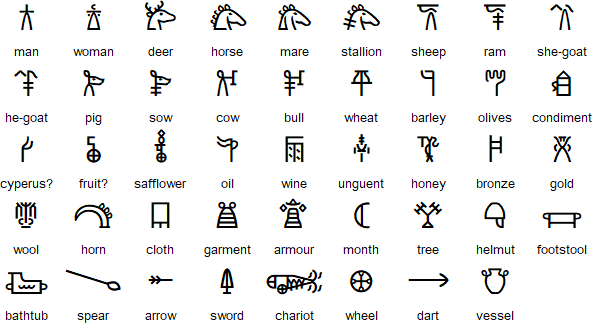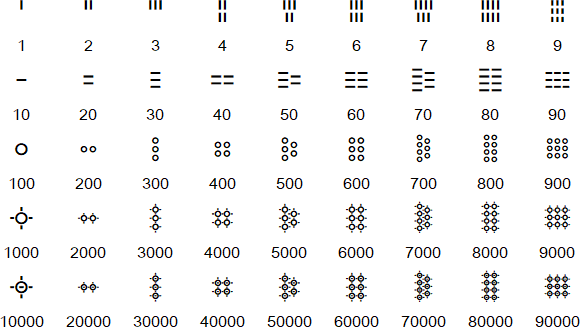In 1900 the archaeologist Sir Arthur Evans (1851-1941) discovered a large number of clay tablets inscribed with mysterious symbols at Knossos on Crete. Believing he had discovered the palace of King Minos, together with the Minotaur's labyrinth, Evans dubed the inscriptions and the language they represented as 'Minoan'.
Evans spent the rest of his life trying to decipher the inscriptions, with only limited success. He realised that the inscriptions represented three different writing systems: a 'hieroglyphic' script, Linear A and Linear B.
The hieroglphic script appears only on seal stones and has yet to be deciphered. Linear A, also undeciphered, is thought to have evolved from the hieroglyphic script, and Linear B probably evolved from Linear A, though the relationship between the two scripts is unclear.
Evans figured out that short lines in Linear B texts were word dividers. He also deciphered the counting system and a number of pictograms, which led him to believe that the script was mainly pictographic. Evans also discovered a number of parallels between the Cypriot script, which had been deciphered, and Linear B. This indicated that the language represented by Linear B was an ancient form of Greek, but he wasn't prepared to accept this, being convinced that Linear B was used to write Minoan, a language unrelated to Greek.
In 1939, a large number of clay tablets inscribed with Linear B writing were found at Pylos on the Greek mainland, much to the surprise of Evans, who thought Linear B was used only on Crete.
Another person who contributed to the decipherment of Linear B was Alice Kober (1906-1950), a professor of Classics at Brooklyn College in New York, who started by compiling statistics about the use of each of the symbols in the script. She noted where they appeared in words and which symbols they appeared with. This analysis enable her to discover that the language was inflected, and that there were three-word sets with similar suffixes. She worked also out a grid of the related characters.
Michael Ventris (1922-56) was the person who eventually deciphered Linear B in 1953. His interest was sparked in 1936 on a school trip to an exhibition about the Minoan world organised by Arthur Evans. For the next 17 years, Ventris struggled to understand Linear B. At first he was sceptical that the language of Linear B was Greek, even though many of the deciphered words resembled an archaic form of Greek. Later, with the help of John Chadwick, an expert on early Greek, he showed beyond reasonable doubt the Linear B did indeed represent Greek. Alice Kober's three-word sets, which Ventris dubed "Kober's triplets", and grid of characters she compiled helped Ventris with the decipherment as he was able to connect the characters with sounds.
Linear B was used between about 1500 and 1200 BC to write a form of Greek known as Mycenaean, named after Mycenae, where Agamemnon is said to have ruled. It . The Linear B inscriptions, most of which were accounting records listing materials and goods, are the earliest known examples of written Greek.

These logograms stand for whole words and mainly represent items that were traded. As Linear B was used mainly for recording transactions, this is not surprising. Some of the logograms resemble the things the represent, so could be called pictograms. Not all the logograms have been deciphered.


Information about Linear B
http://en.wikipedia.org/wiki/Linear_B
http://linearbknossosmycenae.wordpress.com
http://www.telegraph.co.uk/news/worldnews/europe/greece/10158135/Riddle-of-the-script-how-the-worlds-most-fiendish-language-puzzle-was-solved.html
Linear B transliterator - Μεταγραφέας για τη Γραμμική Β
http://linear-b.kinezika.info/
Linear B inscriptions from Knossos
http://minoan.deaditerranean.com/linear-b-transliterations/
Linear B, Knossos & Mycenae
http://linearbknossosmycenae.wordpress.com/
Free Linear B fonts
http://www.csupomona.edu/~jcclark/fonts/
http://greekfonts.teilar.gr
ALPHABETUM - a Unicode font
for ancient scripts, including Classical & Medieval Latin, Ancient Greek, Etruscan, Oscan, Umbrian, Faliscan, Messapic, Picene, Iberian, Celtiberian, Gothic, Runic, Old & Middle English, Hebrew, Sanskrit, Old Nordic, Ogham, Kharosthi, Glagolitic, Anatolian scripts, Phoenician, Brahmi, Imperial Aramaic, Old Turkic, Old Permic, Ugaritic, Linear B, Phaistos Disc, Meroitic, Coptic, Cypriot and Avestan.
https://www.typofonts.com/alphabetum.html
Akkadian Cuneiform, Ancient Egyptian (Demotic), Ancient Egyptian (Hieratic), Ancient Egyptian (Hieroglyphs), Chinese, Chữ-nôm, Cuneiform, Japanese, Jurchen, Khitan, Linear B, Luwian, Mayan, Naxi, Sawndip (Old Zhuang), Sui, Sumerian Cuneiform, Tangut (Hsihsia)
Page last modified: 15.03.23
[top]
You can support this site by Buying Me A Coffee, and if you like what you see on this page, you can use the buttons below to share it with people you know.

If you like this site and find it useful, you can support it by making a donation via PayPal or Patreon, or by contributing in other ways. Omniglot is how I make my living.
Note: all links on this site to Amazon.com, Amazon.co.uk
and Amazon.fr
are affiliate links. This means I earn a commission if you click on any of them and buy something. So by clicking on these links you can help to support this site.
[top]